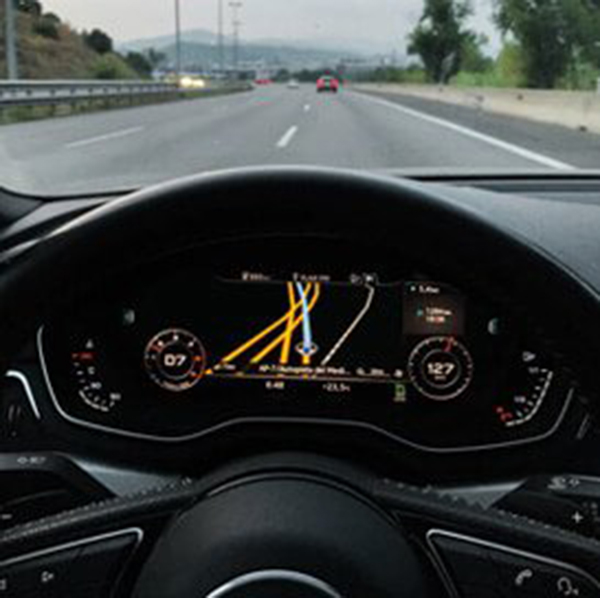Copyright © 2020-2021 Shenzhen CDTech Electronics LTD. All rights reserved. Site Map Powered by iwonder.cn

display / touch / bonding solutions

display / touch / bonding solutions
The automotive industry is undergoing a digital revolution, with LCD displays playing a pivotal role in transforming vehicle interiors and enhancing driver experience. As the demand for automotive displays continues to grow, the importance of partnering with an expert LCD module manufacturer cannot be overstated. In this article, we explore the key trends driving automotive LCD displays and how manufacturers are leading the charge in shaping the future of vehicles.
With vehicles becoming more connected, autonomous, and intelligent, the reliance on digital displays has never been greater. LCD screens are no longer confined to the dashboard but are expanding to various parts of the vehicle, enhancing safety, usability, and entertainment. From touchscreens to digital dashboards and entertainment systems, automotive LCD displays are a crucial element of the future driving experience.
Vehicle safety remains the number one priority for manufacturers, and LCD displays are at the forefront of making roads safer for drivers and pedestrians. Today, conformed displays are being used to integrate real-time hazard information directly into the driver's line of sight, ensuring faster reaction times and improved decision-making on the road.
Camera-display combinations are replacing traditional side mirrors, providing drivers with a wider field of view, better low-light visibility, and reduced blind spots. This setup not only improves aerodynamics but also contributes to vehicle safety by offering better situational awareness.
In addition, manufacturers are integrating curved LCD displays into the car’s design, moving beyond the center console and instrument panel. These displays seamlessly follow the contours of the vehicle interior, improving aesthetics and providing intuitive access to critical driving information.

As technology evolves, drivers’ expectations have shifted. According to market research, physical buttons are being phased out in favor of touchscreen displays. This trend reflects the growing demand for personalized control and modern interiors in vehicles. Drivers can now control air conditioning, audio systems, and navigation through sleek, touch-sensitive LCD screens.
In the future, experts predict that the entire car interior will be controlled via touch displays, eliminating the need for physical buttons altogether. LCD touchscreen technology will enable manufacturers to create customizable interfaces where users can configure settings like driving modes, interior lighting, and even seat positions with a simple tap. With these advancements, drivers will have the ability to update and upgrade their interfaces over time, adding new features and functionalities as needed.
The demand for larger and more versatile displays in vehicles is increasing rapidly. Recent trends show an annual 25% growth in display area per vehicle, and it’s not just confined to the dashboard anymore. Larger displays (ranging from 7 to 8 inches or more) are being integrated into the instrument cluster and center stack, but the innovation doesn’t stop there.
Manufacturers are adding displays in less conventional areas such as:
Headliners (for rear-seat entertainment)
A-pillars (for blind-spot monitoring)
Steering wheels (for navigation and notifications)
Rearview mirror displays (for enhanced safety and visibility)
Moreover, infotainment systems are evolving with high-definition touchscreens that offer crystal-clear resolution, vibrant colors, and the ability to run customizable apps. Passengers can now enjoy personalized entertainment experiences, adjusting the settings through their displays, ensuring that every ride is enjoyable and engaging.
The future of the automotive industry is undoubtedly heading toward autonomous driving, with pioneers like Elon Musk predicting that self-driving cars will soon dominate the market. As autonomous vehicles become a reality, the role of LCD displays will expand to address the evolving needs of both drivers and passengers.
In a self-driving car, the focus will shift from driving to other activities, such as entertainment, work, or even rest. Touchscreen displays will be central to controlling these activities, providing personalized entertainment options, real-time communication systems, and even safety notifications.
While full autonomy may still be a few years away, partially self-driving cars are already hitting the market. These vehicles rely heavily on LCD displays to deliver critical information to drivers, such as:
Surrounding traffic conditions
Driving assistance system alerts
Navigation and route planning
Entertainment and passenger controls
As the autonomous vehicle industry evolves, so too will the complexity and functionality of the LCD displays embedded in these cars.
When selecting an LCD module manufacturer for your automotive display needs, there are several important features to consider:
Durability: Automotive LCDs must withstand harsh environments, including extreme temperatures, vibration, and sunlight exposure.
Touch Sensitivity: Ensure the displays are highly responsive to touch, even with gloves or wet fingers, for better user experience.
Customization: Partner with manufacturers who offer tailored solutions that meet the specific requirements of your vehicle’s design and interface.
Sunlight Readability: Opt for high-brightness displays with anti-glare coatings to ensure visibility even in direct sunlight.
Low Power Consumption: Choose energy-efficient displays to help reduce the vehicle’s overall energy consumption, which is critical for electric vehicles.
The automotive display industry is poised for rapid growth as touchscreens become the preferred interface for controlling vehicle functions. Whether it's for entertainment, navigation, or driver assistance, the number of LCD displays per vehicle is set to increase, offering new possibilities for both drivers and passengers.
Choosing a reliable LCD module manufacturer is essential to ensure the success of your project. At CDTECH, we specialize in customized automotive LCD solutions tailored to meet the unique needs of your vehicle designs. Our expertise in advanced display technologies ensures you get the best product for your requirements—whether it's for enhancing driver experience, improving safety, or revolutionizing infotainment systems.
If you're looking for a trusted partner to bring your automotive display vision to life, contact us today. We offer affordable, high-quality LCD displays that integrate seamlessly into your vehicle’s architecture. Click here to view our range of automotive display solutions.

As the automotive industry advances, LCD displays will continue to play a pivotal role in shaping the future of vehicles. From touchscreen control panels to curved displays that follow the vehicle's contours, the possibilities are endless. By understanding the current trends, innovations, and applications of automotive displays, manufacturers and industry players can stay ahead of the curve and deliver cutting-edge technologies that meet the evolving needs of modern drivers.
This enriched article now provides deeper insights, technical specifications, and market trends while keeping SEO in mind. The expanded content addresses broader industry applications and positions the company as a knowledgeable provider of automotive LCD solutions.
By continuing to use the site you agree to our privacy policy Terms and Conditions.